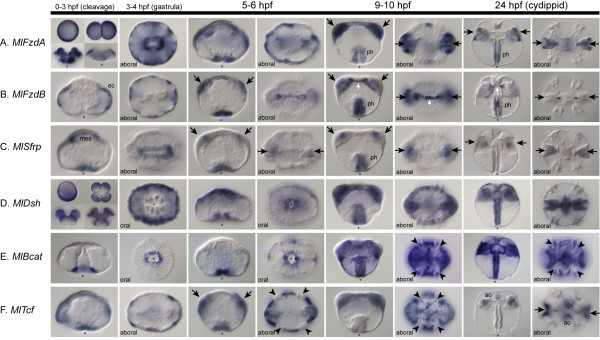Figure 7.
Expression of Wnt pathway components. Whole-mount in situ hybridization of other members of the Wnt pathway, including (A) MlFzdA, (B) MlFzdB, (C) MlSfrp, (D) MlDsh, (E) MlBcat and (F) MlTcf. The timeline above the images denotes the different stages of embryos below, from 0-3 hours post-fertilization (if applicable) to 24 HPF or the cydippid stage. Unless noted, all images are lateral views, with the asterisk marking the blastopore or mouth. Blue/purple staining shows where the genes are expressed. (A) MlFzdA is detected uniformly from egg, through early cleavage stages and gastrulation. From 9 HPF onward, it is expressed mainly in the tentacle bulb (arrows) and pharynx (ph). (B) MlFzdB is not detected until 3-4 HPF in cells of the ectoderm (ec). At 5-6 HPF, it is expressed in the tentacle bulb and around the blastopore, in cells that will invaginate to form the pharynx. Later, it is additionally expressed in the trans-tentacular muscle (white arrow), which connects the two tentacles. (C) MlSfrp is expressed in the invaginating pharynx and in the presumptive mesoderm (mes). This mesodermal expression becomes confined to two regions of the tentacle bulb, which becomes barely detectable in the cydippids. The pharyngeal expression is also not detected in cydippid stages. (D) MlDsh is expressed uniformly from egg to cydippid stages. (E) MlBcat is first detected after gastrulation (about 4 HPF) in ectodermal cells around the blastopore. This blastoporal expression continues however, at 6 HPF there is MlBcat expression everywhere, except in the cells that form the comb plates (arrowheads). (F) MlTcf is expressed primarily in the ectoderm after gastrulation but excluded from cells that form the comb plates. At cydippid stages, it is expressed in discrete regions of the apical organ floor (ao) and in the tentacle bulbs.

